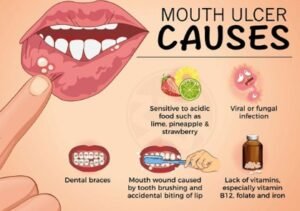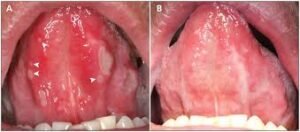Understanding Aphthous Ulcers
Aphthous ulcers, commonly known as canker sores, are small, painful sores that develop inside the mouth. They are typically round or oval, less than 1 centimeter in diameter, and often white or gray with a red border. These ulcers can appear on the inside of the cheeks, lips, tongue, or gums and can affect people of all ages.

Causes of Aphthous Ulcers
The exact cause of aphthous ulcers remains unknown, but several factors may contribute to their development, including:
- Stress: A common trigger for aphthous ulcers.
- Nutritional Deficiencies: Lack of iron, vitamin B12, or folate may increase the risk.
- Allergic Reactions: Allergies to certain foods or substances can trigger ulcers.
- Autoimmune Diseases: Conditions like celiac disease or Crohn’s disease are sometimes associated with aphthous ulcers.

Treating Aphthous Ulcers
Most aphthous ulcers heal on their own within 10-14 days. However, there are ways to relieve the pain and discomfort they cause:
Over-the-Counter Remedies
- Avoid Acidic Foods and Drinks: Acidic items can irritate ulcers and increase pain.
- Pain Relievers: Ibuprofen or acetaminophen can help reduce pain and inflammation.
- Topical Medications: Benzocaine or lidocaine can numb the pain temporarily.
- Mouthwash: Using an antiseptic mouthwash can help kill bacteria and reduce inflammation.

Prescription Medications
For frequent or severe aphthous ulcers, a doctor may prescribe:
- Corticosteroids: Anti-inflammatory medications to reduce pain and size of ulcers.
- Immunosuppressants: To suppress the immune system in severe cases.
- Antiviral Medications: Useful if ulcers are caused by viral infections.
- Antibiotics: If ulcers are infected with bacteria.
Preventing Aphthous Ulcers
There is no guaranteed way to prevent aphthous ulcers, but the following measures can help reduce the risk:
- Healthy Diet: Ensure a diet rich in fruits, vegetables, and whole grains to maintain a strong immune system.
- Stress Management: Practice stress-reducing techniques like exercise, meditation, or spending time with loved ones.
- Avoid Irritating Foods and Drinks: Steer clear of acidic, hot, or spicy foods and beverages.
- Good Oral Hygiene: Brush and floss regularly to remove plaque and bacteria.

Types and Symptoms of Aphthous Ulcers
Types of Aphthous Ulcers

- Minor Aphthous Ulcers: Small, usually less than 5 mm, and not very painful.
- Major Aphthous Ulcers: Larger than 5 mm, often painful and can last for weeks to months.

- Herpetiform Ulcers: Multiple pinpoint lesions that can fuse together, resembling herpes but not caused by the herpes virus.
Symptoms
- Pain: Localized pain that can make eating, drinking, and talking uncomfortable.
- Appearance: Shallow ulcers that start pale yellow and may turn gray, often ringed with red.

Diagnosing Aphthous Ulcers
Diagnosis typically involves a medical examination and a review of the patient’s medical history. If recurrent or severe, additional tests may be conducted to rule out other conditions like celiac disease, Crohn’s disease, or HIV/AIDS.

Complications and Home Remedies
Complications
In rare cases, aphthous ulcers can become infected with bacteria, requiring antibiotic treatment. Persistent ulcers may necessitate further investigation to rule out more serious conditions.

Home Remedies
- Salt Water Rinse: Helps clean the ulcer.
- Baking Soda Rinse: Can neutralize acids in the mouth.
- Milk of Magnesia: Apply to the ulcer to reduce pain.
- Ice Chips: Reduce swelling.
- Teething Ointments: Provide temporary pain relief.
- Stress Reduction: Helps prevent outbreaks.
Conclusion
Aphthous ulcers are common and usually harmless but can be painful and inconvenient. By understanding the triggers and implementing preventive measures, one can reduce the frequency and severity of these ulcers. Proper treatment and care can help manage the symptoms effectively, ensuring a quicker and less painful recovery.



